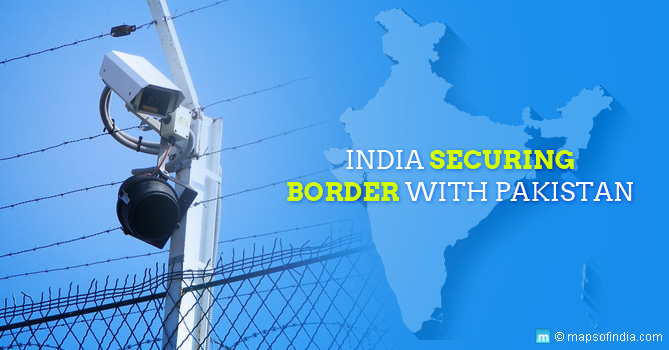The Pathankot airbase attack in January 2016 brought cross border terrorism and infiltration attempts into sharp focus. Not willing to take such security issues lightly any longer, the Government of India has taken an unprecedented decision – to lock down the 2900 kilometer long border between India and Pakistan using a 5 layered, advanced technology based system. Never before, since the two countries separated has there been any attempt to completely seal the borders this effectively. The tech-savvy, NDA administration, however, seems to be willing to set new standards in preventing nefarious threats to the nation’s security and well-being.
Comprehensive Integrated Border Management System (CIBMS)
According to a Times of India news report on 11 April, 2016, the government has given approved of a ‘Comprehensive Integrated Border Management System’ (CIBMS) – one of the most advanced infiltration control systems in use. The CIBMS is a many pronged, multi layered approach to lock down the India Pakistan border. Technology based coverage through the CIBMS includes the use of CCTV cameras, an advanced surveillance radar, laser barriers, the latest thermal imaging devices including night vision goggles and cameras, and underground sensors. The CIBMS will be used to monitor and prevent infiltration through the border round the clock, all days of the year.
The use of a five-layered integrated setup is necessary to ensure that others shall still be available to assist our security forces in detecting and preempting any infiltration attempt. The project will completely sanitize the border and prevent any possible breach of security from the Pakistani side.
Currently there are about 130 unfenced sections along the western border, most of which are over riverines or mountainous regions. These are frequently used by miscreants to enter the country. Under the proposed system, these sections will now be covered by laser barriers which will foil any security breach.It is likely that this 24*7 surveillance will be conducted through manned BSF control rooms set up after every 5 or 6 kilometres.
Points to Ponder
Commissioning the CIBMS across the 2900 kilometre long border that India shares with Pakistan (LOAC) will cause quite a strain on the exchequer. The cost of setting up the CIBMS across a one kilometre stretch will cost about INR 1 crore. Despite the costs, the government has undertaken the project as its final recourse to preserve national security. Significantly, this decision comes shortly after China used its veto to block India’s move to blacklist Masood Azhar at the UN Security Council. Masood Azhar is the founder of the Jaish-e-Mohammed (JeM) and the mastermind behind the attack on Pathankot airbase earlier this year. China’s veto is believed to have come after a consultation with Pakistan and the PRC statement asking India to “love its neighbour” even as the national security is at stake, seems not to have gone down well with the NaMo sarkaar. The CIBMS is looked upon as an attempt to create watertight border security arrangements and end infiltration completely.
Work on two pilot CIBMS projects are already on in Jammu and Punjab (5 kilometre stretches each) and the government is soon to fund similar projects for a 30 kilometre stretch each in Gujarat and Punjab. A fortnight ago a global tender was floated for the 2 pilot projects and it is expected that some 50 – 60 companies will be involved in the setting up of the technological surveillance across the length of the border. Not only with the 360 degrees imaging of the radars prevent any breach of the border, it will also help India locate any attempt from our soil to assist infiltrators, the MOD believes.
Current Measures In Place
Currently, about 70 battalions of the Border Security Force or BSF are deployed on the Indo-Pakistan border stretching all the way from Kashmir in the north to Kutch in the west, though only about two-third of them are physically present at the border. Indian states that share borders with Pakistan include Jammu & Kashmir, Punjab, Rajasthan, and Gujarat.There are CCTVs placed at strategic points and thermal imagery is used for night vision but the technology is rudimentary and the CIBMS is set to change this. To aid border patrol parties, about 50000 poles have been set up along the border with 150000 floodlights and all movements across the border are tracked by security personnel with the help of binoculars. The human element being fallible and easily evaded, the need for superior technology to guard the border has been felt.
Cross Border Infiltration Attempts
According to the ToI report that details out the CIBMS, there have been some 222 infiltration attempts from Pakistan in the year 2014 and about a 100 in 2015. India has strong evidence to believe that most of the worst terrorist episodes on our land including the Indian Parliament attack of 2001, the Mumbai Terror Attacks of 2008, the Pathankot airbase attack of 2016 were all carried out by militant infiltrators from across the border. The JeM and other terrorist groups have repeatedly been breaching Indian borders to send militants and ammunition across the LOAC. It now seems clear that the only way national security may be protected is by using advanced technology to seal our borders.





